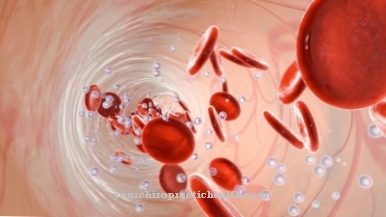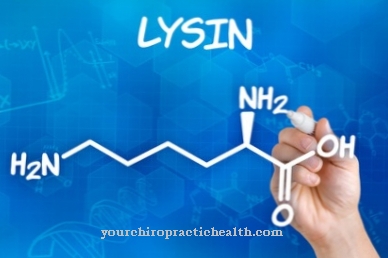A Alkylation indicates the transfer of an alkyl group from one molecule to another. Alkylation has a mutagenic and carcinogenic effect, because DNA and RNA are often attacked and changed by alkylating agents. The so-called alkylating agents are used in medicine on the one hand to inhibit cell growth as cytostatics and on the other hand they trigger cancer or lead to genetic damage in the offspring.
What is the alkylation?

Certain chemical substances develop mutagenic and carcinogenic effects due to their ability to cause alkylation. During the alkylation, alkyl groups are transferred. Methylation is a special case of alkylation. The methyl group also belongs to the alkylene group. However, methylations always take place in the body under physiological conditions, while alkyl groups with more than one carbon atom are usually caused by exogenous substances.
DNA methylation is responsible for epigenetic changes. Many other methylation reactions also take place in the organism. In the process, methyl groups are transferred to specific functional groups such as hydroxyl, amino or sulfhydryl groups.
When ethyl, propyl or even higher-chain alkyl groups are transferred, the genetic material is particularly impaired. The more alkyl groups that bind to the DNA, the more often the DNA strands break. Furthermore, different strands can also be connected to one another. After all, higher-chain alkylations always lead to changes in the nucleic acid molecules. As a result of the nucleic acid changes, among other things, cell growth is inhibited.
Function & task
Due to the growth-inhibiting effect of alkylations, there are possible applications in the fight against cancer. Although alkylating compounds are carcinogenic, they can also stop the uninhibited growth of existing cancer cells. By destroying the DNA, the growth of proliferating cells (dividing cells) is interrupted at so-called checkpoints of the cell cycle. The cell slowly dies. This applies to both cancer cells and cells that undergo strong growth under physiological conditions, such as immune cells, mucous membrane cells, hair root cells and germ cells.
In every cell there are changes in the DNA, but the effect and intensity is greatest in proliferating cells. The cells that divide particularly quickly are therefore most affected. This is the basis for the selective effect of the cytostatics on cancer cells. That is why many alkylating cytostatics are used in cancer therapy in the context of chemotherapy.
With long-term use of these substances, their harmfulness increases, since to a lesser extent, more slowly growing cells are genetically modified. In the special case of methylation, the DNA is also methylated to a large extent. However, there is no genetic change. The base sequence is retained. Methyl groups are only bound to the cytidine. The methylated areas of the DNA are inactive, so that the genetic code can no longer be read here. This leads to epigenetic changes in the DNA. So the DNA is modified, whereby the genetic code is preserved.
Due to epigenetic changes, the body also changes in the form of modifications of the phenotype. It is precisely these processes that are responsible for the influence of the environment on the development and expression of characteristic properties that are not completely determined by the genotype. The differentiation of the individual cells into different organs and tissues also has to do with epigenetic changes. Differentiation is caused by the different activity of genes in different cell types.
Illnesses & ailments
The basis of chemotherapy is based on the cytostatic effect of alkylating substances. At the same time, however, the strong side effects of chemotherapeutic agents are also due to their alkylating effect. These active ingredients develop their therapeutic effect against cancer due to their growth-inhibiting influence on the cells. The cancer cells grow the fastest. That is why they are most influenced.
However, the immune cells, the mucous membrane cells or the germ cells are also impaired in growth. As a result, the known side effects of chemotherapy manifest themselves in susceptibility to infection, nausea, vomiting, anemia, hair loss, dry mucous membranes and other unpleasant symptoms.
Important cytostatic agents for chemotherapy are derivatives of nitrogen mustard compounds, alkyl sulfonates, nitrosoureas and various other groups of substances. What they all have in common is an alkylating effect on the DNA, which is destroyed in the process. All active ingredients can be used for cancer therapy, but have the corresponding unpleasant side effects. If a healthy person comes into contact with these substances, their risk of developing cancer increases.
The short-term effect of these substances is to stop cell division and the cells to die. The gradual changes in DNA in slowly growing cells can also lead to their conversion into cancer cells in the long term.
Also, alkylating chemical compounds in industry and the food industry sometimes develop carcinogenic and mutagenic effects. These include dimethyl sulfate in the chemical industry and the cold disinfectants dimethyl bicarbonate and diethyl bicarbonate in the food industry.
The body's own methylations can also lead to diseases if they are incorrect. Increased or decreased gene activity is based on the methylation of DNA. However, when methylation is defective, diseases develop. Incorrect gene activation can lead to tumors, for example. This is true when a regulatory gene for cell division is inactive. Activation of genes that should normally be inactive can also lead to cell degeneration. Different methylation patterns were found in various tumors compared to the corresponding healthy tissues. It does not matter whether the degree of methylation is too strong or too weak.

























.jpg)

.jpg)
